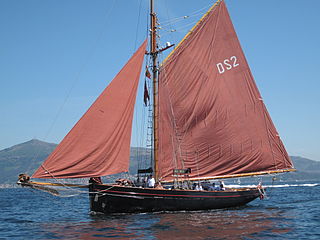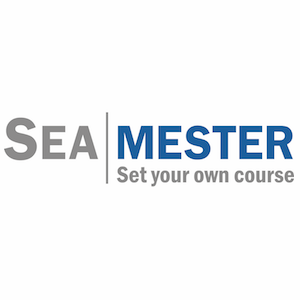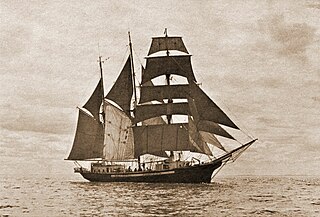
A brig is a type of sailing vessel defined by its rig: two masts which are both square-rigged. Brigs originated in the second half of the 18th century and were a common type of smaller merchant vessel or warship from then until the latter part of the 19th century. In commercial use, they were gradually replaced by fore-and-aft rigged vessels such as schooners, as owners sought to reduce crew costs by having rigs that could be handled by fewer men. In Royal Navy use, brigs were retained for training use when the battle fleets consisted almost entirely of iron-hulled steamships.

A tall ship is a large, traditionally-rigged sailing vessel. Popular modern tall ship rigs include topsail schooners, brigantines, brigs and barques. "Tall ship" can also be defined more specifically by an organization, such as for a race or festival.

USCGC Eagle (WIX-327), formerly the Horst Wessel and also known as the Barque Eagle, is a 295-foot (90 m) barque used as a training cutter for future officers of the United States Coast Guard. She is one of only two active commissioned sailing vessels in the United States military today, along with USS Constitution which is ported in Boston Harbor. She is the seventh Coast Guard cutter to bear the name in a line dating back to 1792, including the Revenue Cutter Eagle.

Jolie Brise is a gaff-rigged pilot cutter built and launched by the Albert Paumelle Yard in Le Havre in 1913 to a design by Alexandre Pâris. After a short career as a pilot boat, owing to steam replacing sail, she became a fishing boat, a racing yacht and a sail training vessel.

From its modern interpretations to its antecedents when maritime nations would send young naval officer candidates to sea, sail training provides an unconventional and effective way of building many useful skills on and off the water.

The STS Kaisei (海星), meaning “Sea Star” in the Japanese language, is a steel-hulled brigantine designed by Polish naval architect Ryszard Langer. It was built as Schooner in Elbląg, Poland in 1987. After re-rigging it is now a two-masted vessel, square rigged on the foremast, with fore-and-aft sails on the mainmast.
The Tall Ships Challenge is an annual event organized by Tall Ships America alternating in a three year cycle between the Great Lakes, the Pacific and the Atlantic coasts of North America.
Operation Sail refers to a series of sailing events held to celebrate special occasions and features sailing vessels from around the world. Each event is coordinated by Operation Sail, Inc., a non-profit organization established in 1961 by U.S. President John F. Kennedy, and must be approved by the United States Congress. Often referred to as OpSail or Op Sail, the event has the goals of promoting good will and cooperation between countries while providing sail training and celebrating maritime history. It is also sometimes erroneously referred to as "Tall Ships". While the tall ships form the centerpiece of the event, smaller sailing vessels also participate.

INS Tarangini is a three-masted barque, commissioned in 1997 as a sail training ship for the Indian Navy. She is square rigged on the fore and main masts and fore-and-aft rigged on the mizzen mast. She was constructed in Goa to a design by the British naval architect Colin Mudie, and launched on 1 December 1995. In 2003–04, she became the first Indian naval ship to circumnavigate the globe.

Lettie G. Howard, formerly Mystic C and Caviare, is a wooden Fredonia schooner built in 1893 in Essex, Massachusetts, USA. This type of craft was commonly used by American offshore fishermen, and is believed to be the last surviving example of its type. She was declared a National Historic Landmark in 1989. She is now based at the South Street Seaport Museum in New York City.

R. Tucker Thompson is a gaff-rigged topsail schooner based in Opua, Bay of Islands, New Zealand. She is operated as a non-for profit charitable trust and owned by the R. Tucker Thompson Sail Training Trust. The mission of the trust is “Learning for Life through the Sea”. The ship is used for tourism day sails in the Bay of Islands from October through April and for sail training activities between May and September. Youth sail training is particularly focused at youth from the Tai Tokerau Northland region of New Zealand. She is a member of the Australian Sail Training Association (AUSTA), and participated in the American Sail Training Association (ASTA) West Coast Tall Ships Challenge events in 2002 and 2005.

Seamester is part of the Global Expeditions Group, an organization that offers academic, study abroad programs on board three sailing vessels, Ocean Star, Argo and Vela. Sea|mester began running programs in 1998 as an extension from its sister organization ActionQuest. A full semester's course load is offered on board including classes in Oceanography, Marine Biology, Professional Skipper Certification Training, Leadership, Basic Seamanship, and an Independent Research Project. Courses are accredited through the University of South Florida (USF).
Barclay Harding Warburton III was founder of the American Sail Training Association, now Tall Ships America.

The Tall Ships Races are races for sail training "tall ships". The races are designed to encourage international friendship and training for young people in the art of sailing. The races are held annually in European waters and consists of two racing legs of several hundred nautical miles, and a "cruise in company" between the legs. Over one half of the crew of each ship participating in the races must consist of young people.

Gertrude L. Thebaud was an American fishing and racing schooner built and launched in Essex, Massachusetts in 1930. A celebrated racing competitor of the Canadian Bluenose, it was designed by Frank Paine and built by Arthur D. Story for Louis A. Thebaud, and named for his wife, Gertrude Thebaud. In their first meeting at Gloucester, Massachusetts in October 1930, Gertrude L. Thebaud bested Bluenose 2-0 to win the Sir Thomas Lipton International Fishing Challenge Cup. However, in 1931, two races to none, and again in 1938, three races to two, Bluenose defeated Gertrude L. Thebaud to remain the undefeated holder of the International Fisherman's Trophy. During World War II, the schooner saw service with the United States Coast Guard. The vessel sank in 1948 off the coast of Venezuela.

Matthew Turner was an American sea captain, shipbuilder and designer. He constructed 228 vessels, of which 154 were built in the Matthew Turner shipyard in Benicia. He built more sailing vessels than any other single shipbuilder in America, and can be considered "the 'grandaddy' of big time wooden shipbuilding on the Pacific Coast."

The sailing ship Regina Maris was originally built as the three-masted topsail schooner Regina in 1908. She was a 144-foot (44-meter), wooden, completely fore-and-aft–rigged sailing ship with three masts. She was re-rigged in 1963 as a 148-foot (45-meter) barquentine. Regina Maris could reach a speed of up to 12 knots, especially on a half-wind course or with a fresh back-stay breeze.

Roald Amundsen, originally named Vilm, is a German steel-ship built on the Elbe River in 1952. Having worked in different areas, she was refitted in 1992 to 1993 as a brig and now serves as a sail training ship. During summer, she usually operates in the Baltic Sea, and usually embarks for journeys to farther destinations for winter, including several trans-Atlantic crossings.

Seute Deern is a wooden, gaff-rigged ketch built as the cargo ship Havet in Svendborg, Denmark in 1939 for Captain Karl Lorenzen. Sold in 1956 to J. Lauritzen and renamed Noona Dan. Noona Dan circumnavigated the world in 1961/1962 on the Danish research cruise known as the Noona Dan expedition to the Western Pacific Ocean. After the expedition the ship was sold to Germany as a training ship, first owned and operated by Deutsche Schulschiff-Verein and 1973 by the German Clipper association. She continues to sail with young people on training cruises in the Baltic Sea. In winter the ship is moored at Hamburg-Harburg.

The Harvey Gamage is a 131' gaff rigged schooner launched in 1973 from the Harvey F. Gamage Shipyard in South Bristol, Maine. She was designed by McCurdy & Rhodes, Naval Architects in Cold Spring Harbor, New York and Frederick W. Bates of Damariscotta, Maine. She is a USCG inspected vessel both as a passenger vessel and a sail training vessel. As governments of maritime countries recognise Sail Training as an essential component of developing and maintaining an essential merchant marine force, the US Congress created a special service category of vessel for Sail Training and the Harvey Gamage is one of a handful of vessels licensed for this service. She has been educating students at sea along the east coast of North American almost continuously since her launch. She has 14 staterooms accommodating 39 people, including 9 professional crew, 22 youth sail trainees and up to 4 adult chaperones. As a training vessel, she takes crews of students along the eastern seaboard, from her home port in Maine to various destinations ranging from The Maritimes to the Caribbean

















